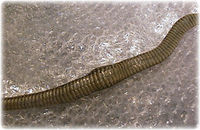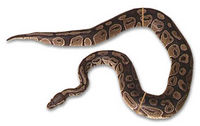Difference between revisions of "Snake Lumps and Bumps"
| (11 intermediate revisions by 3 users not shown) | |||
| Line 1: | Line 1: | ||
| − | + | [[Image:Abscess_lump.jpg|200px|thumb|right|'''The majority of lumps in snakes are abscesses''' ©RVC and its licensors, Peer Zwart and Fredric Frye. All rights reserved]] | |
| − | [[Image:Abscess_lump.jpg|200px|thumb|right|'''The majority of lumps in snakes are abscesses''' | ||
==Examination== | ==Examination== | ||
| − | Abnormal swellings are one of the commonest presentations in | + | Abnormal swellings are one of the commonest presentations in snake. Visible or palpable masses may be either the presenting complaint or they may be found during the physical examination. History will reveal that many lumps such as abscesses and neoplasia will be progressive while others will appear as if they developed overnight. Physical examination will give an indication of aetiology because of position. The differential diagnosis is in part based on the position of the lump in the body. |
| − | |||
| − | |||
| − | |||
| − | |||
| − | |||
==Diagnosis== | ==Diagnosis== | ||
| − | The majority of lumps are abscesses | + | The majority of lumps are abscesses but not all are! Radiology may define the aetiology because of the radiographic appearance. Additionally, haematology and biochemistry, fine needle aspiration, contrast radiography, ultrasonography, endoscopy, biopsy and faecal examination may be used. Culture and sensitivity are especially important. |
| − | |||
| − | |||
| − | |||
| − | |||
| − | |||
| − | |||
| − | |||
| − | |||
| − | |||
| − | |||
| − | |||
| − | |||
| − | |||
==Therapy== | ==Therapy== | ||
| − | Treatment is very varied and dependent on the aetiology but frequently involves | + | Treatment is very varied and dependent on the aetiology but frequently involves surgery to investigate and remove the masses. Treatment of abscesses (one of the most common dermatological problems) involves surgical removal and systemic antibiotics based upon a culture and sensitivity. |
| − | |||
| − | |||
| − | |||
==Prevention== | ==Prevention== | ||
| − | A preventive medicine program | + | A preventive medicine program holds the key to a healthy reptile collection. Good husbandry practices produce animals that are not stressed and conditions not conducive to disease. Hygienic conditions decrease contamination of abscess-forming bacteria. Prophylactic treatments decrease parasite numbers before they become a problem. Veterinary involvement allows treatment to be instigated at an early stage. |
| − | [[Image:Python_3rds.jpg|200px|thumb|right|'''The body can be divided into thirds to aid in a differential diagnosis''' | + | [[Image:Python_3rds.jpg|200px|thumb|right|'''The body can be divided into thirds to aid in a differential diagnosis''' ©RVC and its licensors, Peer Zwart and Fredric Frye. All rights reserved]] |
| − | |||
==Differential diagnosis of lumps== | ==Differential diagnosis of lumps== | ||
| − | The differential diagnosis will depend on the position of the lump in the body so knowledge of the position of organs is important | + | The differential diagnosis will depend on the position of the lump in the body so knowledge of the position of organs is important. Abscesses may occur anywhere in the body and must be included in any differential diagnosis. Neoplasia is similar. Some causes: |
| − | *In the | + | *In the cranial third of the snake - ingested foreign bodies, cardiomyopathies or pericardial effusions, visceral gout and goitre. |
| − | *In the | + | *In the middle third - ingested foreign bodies, intestinal intussusception, visceral gout, cholecystomegaly due to bile duct obstruction or coccidiosis, ripe or atretic follicles, inflammation of any organs including gastritis caused by Cryptosporidium and Monocercomonas, colitis due to Entamoeba, omphalitis and steatitis. |
| − | *In the | + | *In the caudal third - ingested foreign bodies, intestinal intussusception, uric acid colonoliths, renal and visceral gout. |
| − | |||
Revision as of 16:46, 15 March 2010
Examination
Abnormal swellings are one of the commonest presentations in snake. Visible or palpable masses may be either the presenting complaint or they may be found during the physical examination. History will reveal that many lumps such as abscesses and neoplasia will be progressive while others will appear as if they developed overnight. Physical examination will give an indication of aetiology because of position. The differential diagnosis is in part based on the position of the lump in the body.
Diagnosis
The majority of lumps are abscesses but not all are! Radiology may define the aetiology because of the radiographic appearance. Additionally, haematology and biochemistry, fine needle aspiration, contrast radiography, ultrasonography, endoscopy, biopsy and faecal examination may be used. Culture and sensitivity are especially important.
Therapy
Treatment is very varied and dependent on the aetiology but frequently involves surgery to investigate and remove the masses. Treatment of abscesses (one of the most common dermatological problems) involves surgical removal and systemic antibiotics based upon a culture and sensitivity.
Prevention
A preventive medicine program holds the key to a healthy reptile collection. Good husbandry practices produce animals that are not stressed and conditions not conducive to disease. Hygienic conditions decrease contamination of abscess-forming bacteria. Prophylactic treatments decrease parasite numbers before they become a problem. Veterinary involvement allows treatment to be instigated at an early stage.
Differential diagnosis of lumps
The differential diagnosis will depend on the position of the lump in the body so knowledge of the position of organs is important. Abscesses may occur anywhere in the body and must be included in any differential diagnosis. Neoplasia is similar. Some causes:
- In the cranial third of the snake - ingested foreign bodies, cardiomyopathies or pericardial effusions, visceral gout and goitre.
- In the middle third - ingested foreign bodies, intestinal intussusception, visceral gout, cholecystomegaly due to bile duct obstruction or coccidiosis, ripe or atretic follicles, inflammation of any organs including gastritis caused by Cryptosporidium and Monocercomonas, colitis due to Entamoeba, omphalitis and steatitis.
- In the caudal third - ingested foreign bodies, intestinal intussusception, uric acid colonoliths, renal and visceral gout.

